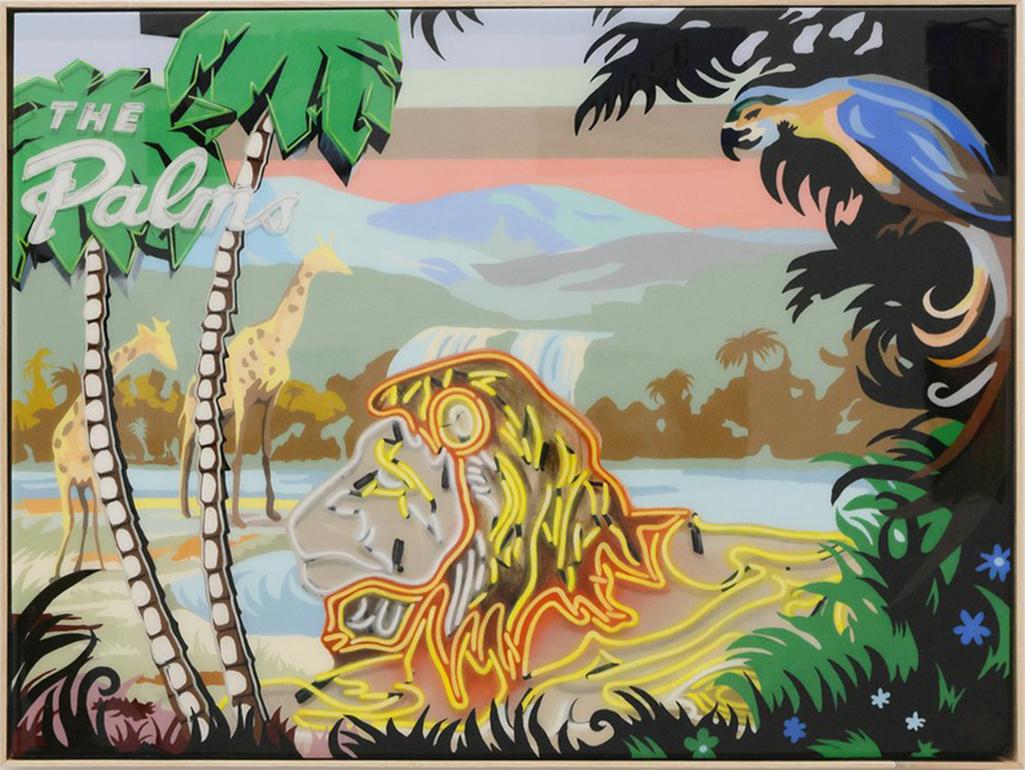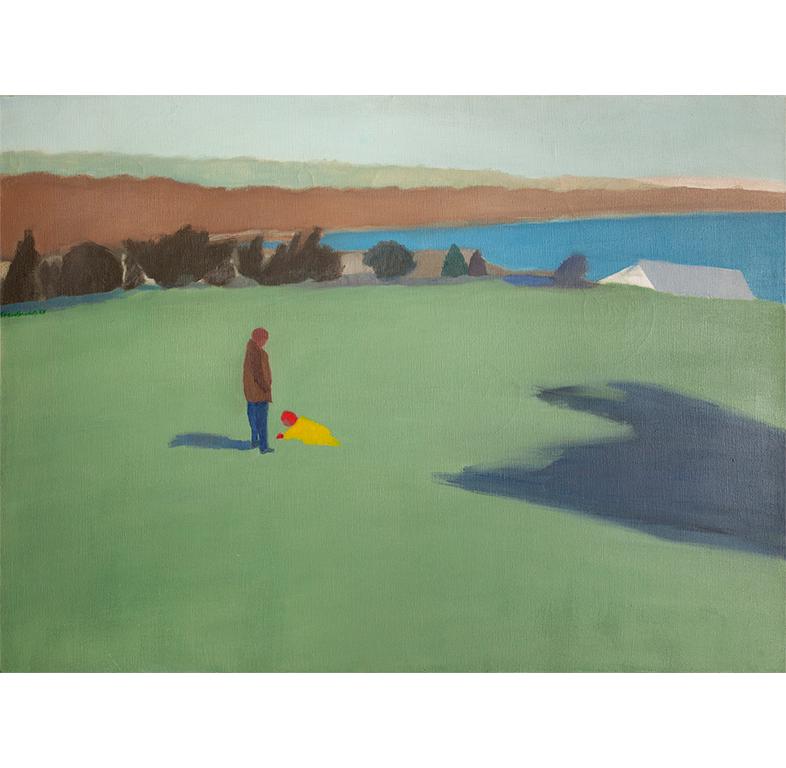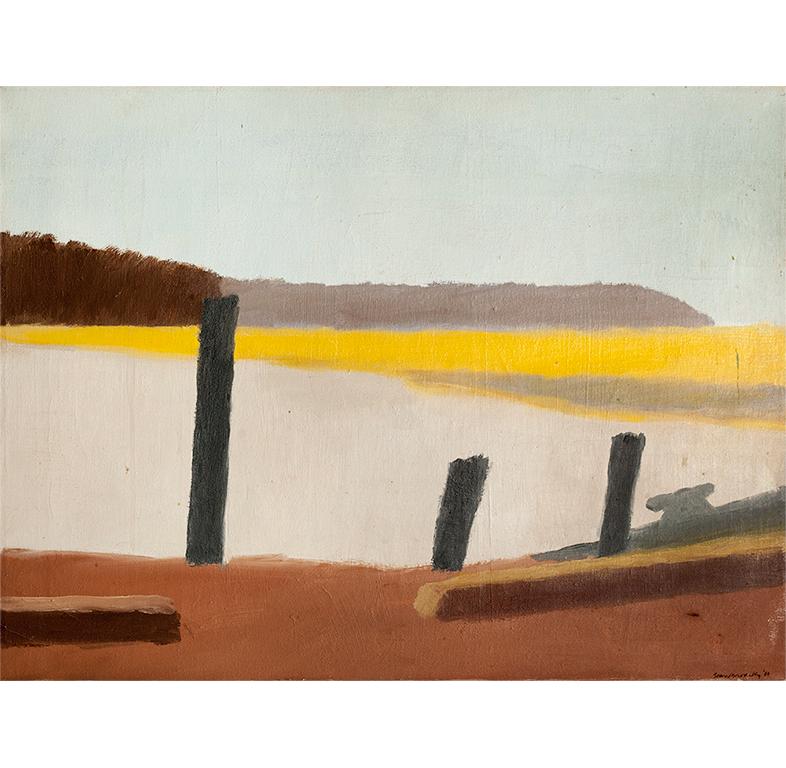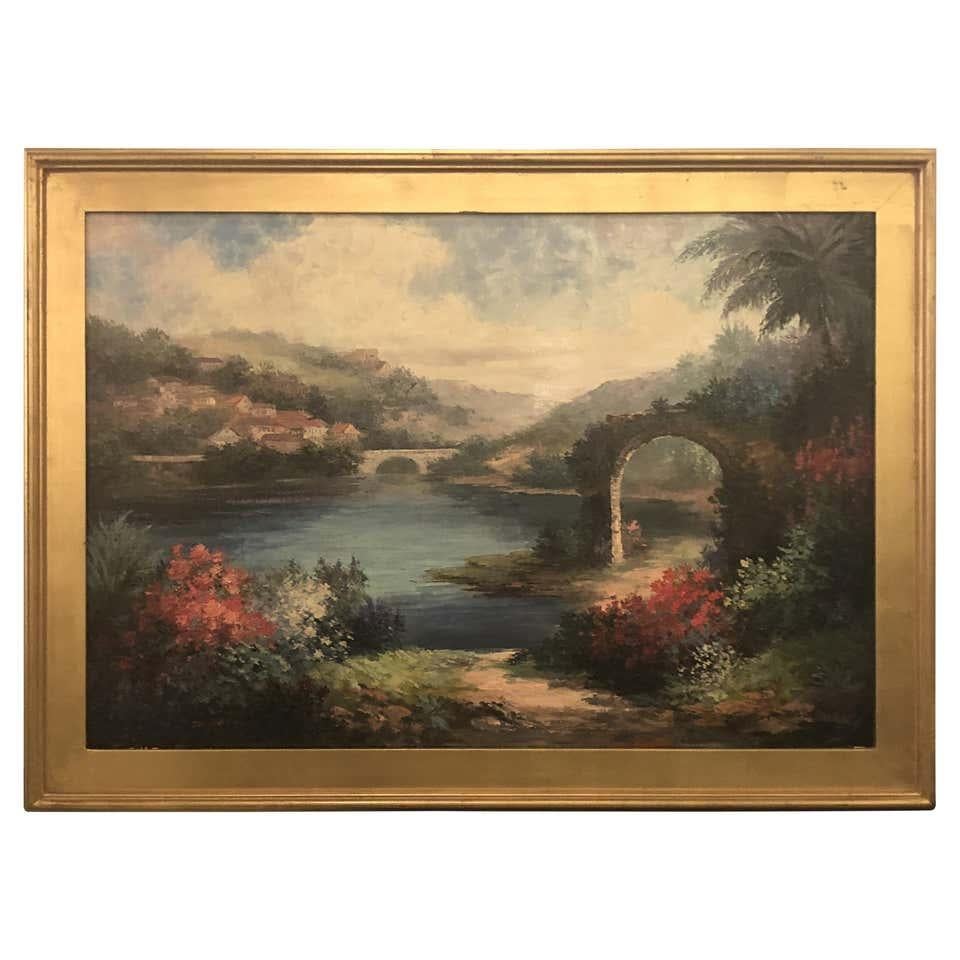Items Similar to Exterior Stairway
Want more images or videos?
Request additional images or videos from the seller
1 of 5
Edward BibermanExterior Stairwayc. 1970s
c. 1970s
About the Item
Exterior Stairway, c. 1970s, oil on masonite, signed upper right, 12 x 24 inches; illustrated (film) Kaufman, Jeffrey, Brush with Life: The Art of Being Edward Biberman, 2007, (DVD release 2010), 85 minutes
This work is part of our exhibition The Architectural World of Edward Biberman (1904 - 1986)
About the Painting
Exterior Stairway is a prime example of Biberman’s post-war precisionist scenes of Southern California, similar in feeling to The White Fire Escape, which has been in the collection of the Los Angeles County Museum of Art for more than fifty years. Biberman began working with a precisionist vocabulary in New York during the early 1930s upon his return from Paris. During his long career, Biberman consistently depicted architectural subjects as part of his practice. Critics have favorably compared these paintings to 1920s and 30s precisionism as practiced by Charles Sheeler, Louis Lozowick and Ralston Crawford, and noted that Biberman’s early Southern California modernist scenes anticipated those of Ed Ruscha and David Hockney. In a rare commentary on the work of other artists, Biberman himself acknowledged a debt to the great precisionist painter, Charles Demuth. In a 1975 interview, likely around the same time he painted Exterior Stairway, Biberman explained, “[T]here was a painter who deserves to be much better known, the American painter Charles Demuth. [He] painted a canvas that I saw when I was quite young. It was a painting of two great wheat silos, probably someplace in Kansas, and he titled that painting My Egypt. Now, I knew exactly what he meant by that. When I say I've always been fascinated by cities, engineering, [and] structural forms, I speak of something that has, emotionally, touched me very deeply. This interest has always been present in my work when I am not impelled, let us say, to paint things with an overtly social quality. You see, I think of myself as a very lyric painter. I love the look of nature, and I also love the look of many of the things that men build. I find both of these very wonderful, stirring, lyrical experiences.” In Exterior Stairway, we see the lyricism that Biberman found in both the structure of a conventional Southern California parking garage and Los Angeles’ iconic palm trees.
About the Artist
Edward Biberman was one of California’s most important modernist painters. He was born in Philadelphia, the son of Russian Jewish immigrants. Biberman’s artistic career started at the Pennsylvania Academy of Fine Arts followed by three years of study in Paris, where he associated closely with Calder and Noguchi and exhibited at the Salon d'Automne, Grand Palais, in 1927 and the Salon des Independents in 1929. Upon his return to the United States, Biberman spent time in New York City, where he showed at many of the city’s premier galleries and museums. His works were selected for several of the Museum of Modern Art’s early exhibitions of American artists, including 46 Painters and Sculptors Under the Age of 35 (1930) and Murals by American Painters and Photographers (1932). Hoping to escape the pressures of the New York art world, Biberman moved to Los Angeles in 1936 where he could be close to his family, including his film director brother, Herbert Biberman, and his sister-in-law, the Academy Award winning actress, Gale Sondergaard.
During the course of his long career, Biberman showed at the Salon d’Automne (Paris); the Whitney Museum of American Art; Metropolitan Museum of Art (New York), Corcoran Gallery, Los Angeles County Museum of Art (LACMA) and dozens of other museums and galleries across the US and in Europe. He enjoyed over forty-five solo exhibitions and his works were included in over one hundred group shows. Biberman completed three murals for public works projects, including his work Abbot Kinney and the Story of Venice for the Venice Post Office, which was installed for six months at LACMA in 2014. His works are in the permanent collections of more than a dozen museums, including the Museum of Fine Arts, Houston, National Portrait Gallery (of the Smithsonian Institution), Butler Institute of American Art, Pennsylvania Academy of Fine Arts and LACMA. Several books are dedicated to Biberman’s art, as is a feature length documentary, Brush with Life: The Art of Being Edward Biberman (2007). Biberman’s art has undergone a resurgence of popularity during the past fifteen years with four solo or focused exhibitions, Edward Biberman Revisited (2009), Edward Biberman (2011-12), Lost Horizons: Mural Dreams of Edward Biberman (2014) and Edward Biberman, Abbot Kinney and the Story of Venice (2014), and representation in a number of other exhibitions, such as George Ault and 1940s America at the Smithsonian Institution (2011), Pacific Standard Time (2012) and Contraption: Rediscovering California Jewish Artists (2018). He is listed in Who was Who in American Art and all other standard references. Biberman’s portrait of Martin Luther King, I Have a Dream, is currently on view at LACMA at part of Black American Portraits, a companion exhibition to the Obama presidential and first lady portraits.
Biberman’s brand of modernism can fairly be divided into four categories 1) precisionist urban scenes of New York and Southern California which celebrate the creations of humanity; 2) portraits which expose not only the historical context, but also the souls, of his subjects; 3) rural landscapes and still life paintings which portray the beauty of America and its flora; and 4) social realist works which explore the struggles, hopes and shortcomings of our society. Regardless of genre, Biberman had a unique sense of structure and color. His figures are at the same time specific and universal. Taken as a whole, Biberman’s body of work presents the viewer with a compelling and often daring vision of 20th century America and its art.
- Creator:Edward Biberman (1904 - 1986, American)
- Creation Year:c. 1970s
- Dimensions:Height: 24 in (60.96 cm)Width: 12 in (30.48 cm)Depth: 1 in (2.54 cm)
- Medium:
- Movement & Style:
- Period:
- Condition:
- Gallery Location:Los Angeles, CA
- Reference Number:1stDibs: LU1859210018112
About the Seller
No Reviews Yet
Vetted Seller
These experienced sellers undergo a comprehensive evaluation by our team of in-house experts.
1stDibs seller since 2022
6 sales on 1stDibs
Typical response time: 8 hours
- ShippingRetrieving quote...Ships From: Los Angeles, CA
- Return PolicyA return for this item may be initiated within 3 days of delivery.
More From This SellerView All
- Six O'ClockLocated in Los Angeles, CASix O-Clock, c. 1942, oil on canvas, 30 x 20 inches, signed and titled several times verso of frame and stretcher (perhaps by another hand), marked “Rehn” several times on frame (for the Frank K. M. Rehn Galleries in New York City, who represented Craig at the time); Exhibited: 1) 18th Biennial Exhibition of Contemporary American Oil Paintings from March 21 to May 2, 1943 at The Corcoran Gallery of Art in Washington, D.C. #87, original price $450 (per catalog) (exhibition label verso), 2) Craig’s one-man show at the Frank K. M. Rehn Galleries, New York City, from October 26 to November 14, 1942, #10 (original price listed as $350); and 3) Exhibition of thirty paintings sponsored by the Harrisburg Art Association at the State Museum of Pennsylvania in Harrisburg in March, 1944 (concerning this exhibit, Penelope Redd of The Evening News (Harrisburg, Pennsylvania) wrote: “Other paintings that have overtones of superrealism inherent in the subjects include Tom Craig’s California nocturne, ‘Six O’Clock,’ two figures moving through the twilight . . . .” March 6, 1944, p. 13); another label verso from The Museum of Art of Toledo (Ohio): original frame: Provenance includes George Stern Gallery, Los Angeles, CA About the Painting Long before Chris Burden’s iconic installation outside of the Los Angeles County Museum of Art, Urban Light, another artist, Tom Craig, made Southern California streetlights the subject of one of his early 1940s paintings. Consisting of dozens of recycled streetlights from the 1920s and 1930s forming a classical colonnade at the museum’s entrance, Burden’s Urban Light has become a symbol of Los Angeles. For Burden, the streetlights represent what constitutes an advanced society, something “safe after dark and beautiful to behold.” It seems that Craig is playing on the same theme in Six O-Clock. Although we see two hunched figures trudging along the sidewalk at the end of a long day, the real stars of this painting are the streetlights which brighten the twilight and silhouette another iconic symbol of Los Angeles, the palm trees in the distance. Mountains in the background and the distant view of a suburban neighborhood join the streetlights and palm trees as classic subject matter for a California Scene painting, but Craig gives us a twist by depicting the scene not as a sun-drenched natural expanse. Rather, Craig uses thin layers of oil paint, mimicking the watercolor technique for which he is most famous, to show us the twinkling beauty of manmade light and the safety it affords. Although Southern California is a land of natural wonders, the interventions of humanity are already everywhere in Los Angeles and as one critic noted, the resulting painting has an air of “superrealism.” About the Artist Thomas Theodore Craig was a well-known fixture in the Southern California art scene. He was born in Upland California. Craig graduated with a degree in botany from Pomona College and studied painting at Pamona and the Chouinard Art School with Stanton MacDonald-Wright and Barse Miller among others. He became close friends with fellow artist Milford Zornes...Category
1940s American Modern Landscape Paintings
MaterialsCanvas, Oil
- The Railway StationLocated in Los Angeles, CAThe Railway Station, c. 1934, oil on canvas, signed lower right, titled verso and noted "34"; illustrated Kaufman, Jeffrey, Brush with Life: The Art of Being Edward Biberman...Category
1930s American Modern Landscape Paintings
MaterialsOil
- Church in TreesLocated in Los Angeles, CAThis painting is part of our exhibition Charles Goeller: A Wistful Loneliness. Oil on canvas, 13 x 9 inches, Signed lower leftCategory
1940s American Modern Landscape Paintings
MaterialsOil, Canvas
- Arthur KillLocated in Los Angeles, CAThis painting is part of our exhibition Charles Goeller: A Wistful Loneliness. Oil on canvas, 15 ¾ x 24 inches, Signed and titled verso on stretcher Exhibited: [Solo Exhibition] Cha...Category
1940s American Modern Landscape Paintings
MaterialsOil, Canvas
- Trees at BloomBy Clarence Holbrook CarterLocated in Los Angeles, CATrees at Bloom, 1939, oil on canvas, 32 x 24 inches, signed lower right About the Painting Trees at Bloom was painted when Clarence Holbrook Carter lived in Pittsburgh and served as an instructor in the Department of Painting and Design at the Carnegie Institute of Technology (now Carnegie-Mellon University), a position he held from 1938 through 1944. It depicts a thick forest at the base of distance hills just outside the city. During his tenure in Pittsburgh, Carter was deeply influenced by not only the industrial might of the steel mills and iron forges of the city, but also the beauty of the surrounding landscape. As Frank Anderson Trapp noted in his book on the artist, for Carter “the terrain itself had its own special vitality, with its craggy, wooded hills threaded with ravine and watercourses . . . . the signs of industrial blight that were unalleviated in some parts of the country were there relieved by the geological variety of the parent landscape, and by the irrepressible presence of its natural growth, which softened the whole.” Trapp continues, “in his scenes of rural situations, Carter had a special gift for rendering those elements convincingly.” With the profusion of flowering trees which diffuse the light and the red cardinals darting from one branch to another, Trees at Bloom portrays the “irrepressible presence of nature” that Trapp describes. About the Artist Together with Charles Burchfield, Clarence Holbrook Carter was Ohio’s premiere American Scene painter and later an innovative magic realist. The son of a no-nonsense public-school administrator, Carter was born in 1904 outside of Portsmouth, Ohio, a small town in the heart of the Ohio River...Category
1930s American Modern Landscape Paintings
MaterialsCanvas, Oil
- Across the StreetLocated in Los Angeles, CAThis painting is part of our exhibition Charles Goeller: A Wistful Loneliness. Oil on canvas, 16 x 12 inches, Signed lower right Exhibited: 1) [Solo E...Category
1940s American Modern Landscape Paintings
MaterialsOil, Canvas
You May Also Like
- Flocks of housesBy FPA Francis Pavy ArtistLocated in Lafayette, LAThis small work, entitled flocks of houses measures 7 inches tall by 5 inches wide. It is oil on canvas on wood sketchers. It's signed on the reverse. The writing on the reverse rea...Category
Early 2000s American Modern Landscape Paintings
MaterialsOil
- Who's the king?Located in Nashville, TNMelissa Sims’ work utilizes motifs from collage and pop art, in that several different images are combined into one cohesive but surreal landscape. Sims c...Category
2010s American Modern Animal Paintings
MaterialsResin, Oil, Acrylic
- Southdown Field at Long Island Sound Beach Parent and childBy Stan BrodskyLocated in Brookville, NYThis large green field overlooking the Long Island Sound Beach depicts a parent without definition, mother or father, observing their child in the gr...Category
1960s American Modern Figurative Paintings
MaterialsOil
- Yellow Shore, A landscape along the beach of the North Shore of Long IslandBy Stan BrodskyLocated in Brookville, NYThis painting on canvas looking out from the shoreline of the beach with dock pilings in the foreground and a yellow field in front of trees across the water. signed on the lower rig...Category
1960s American Modern Landscape Paintings
MaterialsOil
- Moon Glow by Robert TerryLocated in Brookville, NYBorn 1955 in Broken Bow, Nebraska. Lives and works in New York. AWARDS National Endowment for the Arts, Major Grant Robert Terry was best noted in his depictions of romantic moons...Category
1990s American Modern Landscape Paintings
MaterialsOil
- Americana Landscape Oil on Canvas Painting Signed P. Paul, FramedLocated in Plainview, NYAn elegant oil on canvas landscape painting featuring a lake view in a paradisiac environment. The painting is finely framed in custom giltwood frame. A wonderful addition to any liv...Category
1980s American Modern Landscape Paintings
MaterialsCanvas, Oil
Recently Viewed
View AllMore Ways To Browse
Modern Exterior
Exterior Art
Edward View
Edward Love
Mid Century Exterior
Edward Ruscha
Exterior Architectural
Edward Me
Modern Rural Landscape
Mid Century Urban Landscapes
2 Sisters Modern Art
Russian Modernist Painting
1940s Landscape Painting California
Midcentury Urban Landscape
Lyric Art
20th C Russian Art
1940s Modernist Landscape
Edward Hoper





